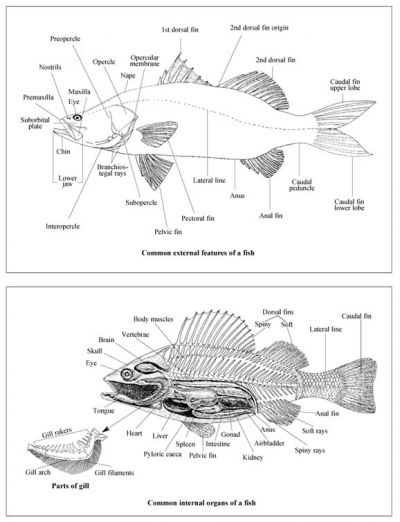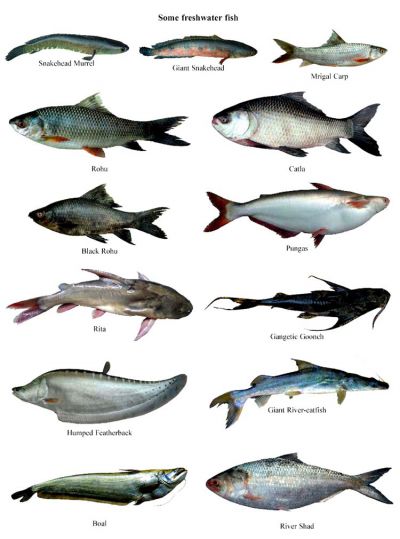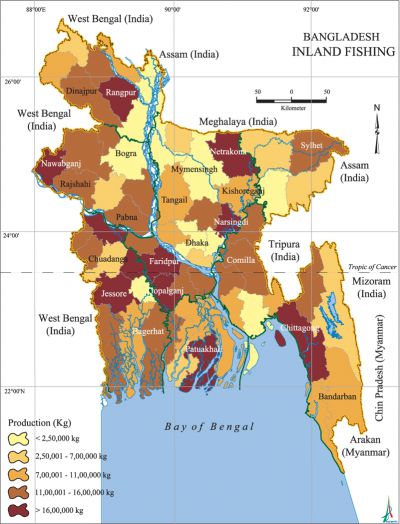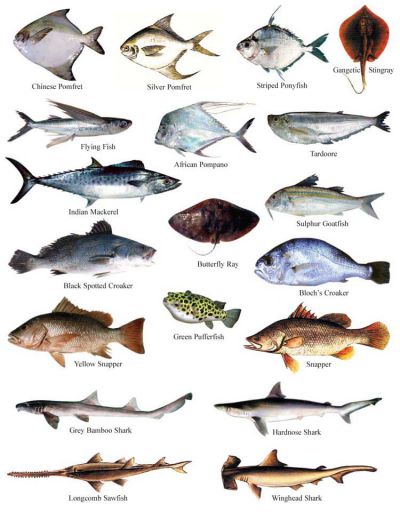Fish
Fish cold-blooded, limbless, completely aquatic vertebrates, having gills, commonly fins, and typically elongated torpedo-shaped body mostly covered with scales. Fish are usually grouped into four classes, three living (Agnatha, Chondrichthyes, and Osteichthyes) and one extinct (Placodermi): 1. Agnatha, the primitive jawless fishes, including the cyclostomes (lampreys and hagfishes) and extinct armoured fishes known as ostracoderms, none of which has gill arches (bony frames for the gills); 2. Placodermi, extinct armoured fishes with jaws; 3. Chondrichthyes, the cartilaginous fishes, including sharks, rays and their allies, all of which have a predominantly cartilaginous skeleton; and 4. Osteichthyes, the bony fishes, including the great majority of food and game fishes. A number of aquatic invertebrate animals and groups have common names compounded with the term fish, which are unrelated to true fish. For example cuttlefish (cephalopod mollusks, relatives of the octopus), jellyfish (coelenterates), starfish (echinoderms), and shellfish (mollusks such as the oyster and clam), and the crustacean arthropods such as the crayfish.

The bony fishes are divided into two groups: the fleshy-finned fish (Crossopterygii) and the ray-finned fish (Actinopterygii). The latter group includes over 95% of all living fish species. The earliest bony fishes were fleshy-finned. They evolved during a period of widespread drought and stagnation and gave rise to the amphibians (the first terrestrial vertebrates) on the one hand, and to the ray-finned fish on the other. The only surviving fleshy-finned fishes are the lungfishes and one species of Coelacanth. These fishes retain some of the traits of ancestral bony fishes: fleshy fins with supporting bones (precursors of the limbs of land vertebrates), internal nostrils, and lungs. Ray-finned fishes are now predominant in both fresh and marine waters.
There are about 32,000 species of fishes worldwide and almost 40% of the species live in fresh water. In Bangladesh there are 401 species of marine fishes. There are 251 species of inland fishes (in freshwaters and brackish waters). Once abundant in the wetlands, the snakehead fishes (Shol, Taki, Gajar etc) are now becoming rare. Of the five species of family Channidae three are threatened: Barca snakehead (Pipla shol), Channa barca, is critically endangered, Giant snakehead (Gajar), Channa marulius, is endangered, and Asiatic snakehead (Telo Taki), Channa orientalis, is vulnerable. Of the eels (usually with two lateral gill-openings), the Gangetic Mudeel (kuichya), Monopterus cuchia, is unique in possessing a single gill-opening on the ventral side. Once abundant, it is now a vulnerable species. Another beautiful eel, the one-stripe spinyeel (Tara Baim), Macrognathus aral, is also now vulnerable. The snake-eels (2 species), Pisodonophis spp., are not usually eaten by the local people, and face no threats at the moment. The largest eel is the Indian Longfin Eel (Bamosh/Bamchara/Bao Baim/Telkoma), Anguilla bengalensis, found in the estuaries and freshwaters; the largest specimen caught from Netrokona was 118 cm long and weighed over 6 kg; the fish is known to be catadromous, and migrates down the rivers to the sea to spawn. Of the gars or crocodile fishes (Kaikka, Kumerir Khil), Deocata Pipefish, Microphis deocata, is now endangered.

Some 76 species of fishes are often included both as freshwater and marine in Bangladesh. The most important (culturally and economically) one is hilsa (Ilish), Tenualosa ilisha, an anadromous fish that migrates down the sea to the rivers to spawn. The immature young ones, locally known as jatka grown in the rivers and its tributaries, descend to the sea for feeding, and on maturity return to freshwater for breeding and to complete the life cycle. The migrating adult fishes are extensively exploited during May to October; the young ones ie Jatka are captured during February to May in the rivers.
Carps are the major fishes in pond culture. The most preferred fish (because of its taste) in Bangladesh is the Climbing Perch (Koi), Anabas testudineus (family Anabantidae, order Perciformes). Although most of the perciforms are marine, a majority enters the estuaries and rivers, such as Pony fishes (Tak-chama), Jew fishes (Poa), thread-fins (Tapasi), mullets (Bata), pomfrets (Rupchanda), etc.
Of the inland fishes, 54 face different categories of threats, of which 12 are critically endangered, 28 are endangered, and 14 are vulnerable. Although about 150 exotic species of freshwater fishes were introduced into the country in the earlier part of this century, and were mostly ornamental or aquarium fish, 13 are cultured in freshwater and brachish water ponds. Gambusia, a larvivorous fish was introduced in the 1930s/1940s to control mosquito. The fishes that are contributing substantially to commercial fisheries are: Chinese Silver Carp, Grass Carp, Big Head Carp, Common Carp, Tilapia, Catfish, Thai Pangas, Sor Punti, etc.

In the subcontinent the fish culture in closed waters like ponds and lakes has been practiced since 350 BC. Sundar Lal Hora, Director of Fisheries of undivided Bengal, between 1932 and 1947 made the first successful attempt in pond fish culture in this subcontinent. Fish culture and fisheries got a momentum in this country after the introduction of induced breeding of carps with pituitary extract in 1967. Once the major carps were the target species, but now many exotic fishes are cultured in ponds and lakes.
Of the total annual fish production about 30% comes from the culture sector and the remaining 70% comes from the inland and marine capture sector. Many fish culture technologies have been developed locally, such as integrated poultry-cum-fish culture, integrated rice-fish culture and pest management, polyculture of carps, improved nursery rearing techniques of carps, mono- and polyculture of Macrobrachium rosenbergii, polyculture of Thai Pangas, and culture of fish in pens and cages.
Freshwater fishes are cultured in about 41,00,000 ha of open waters (rivers, floodplains, beels and haors, lakes, etc), and about 3,50,00 ha of closed waters (eg ponds). Spawn (about 20,000 kg) and fry of major carps are collected from more than 50 spawning grounds in the Padma, Brahmaputra and Jamuna rivers to rear in the nurseries up to fingerling stage. On the other hand about 10,000 kg of spawn are produced annually by artificial spawning in different hatcheries. Mixed fish farming is practiced in many freshwater bodies like ponds, lakes, ditches, etc. The common practices are the culture of Indian major carps, viz., Catla (Catla catla), Rui (Labeo rohita) and Mrigal (Cirrhinus mrigala), with the culture of indigenous small fish species like Mola (Amblypharyngodon mola), Punti (Puntius chola), Kholisa (Colisa fasciatus), etc. Exotic carps like silver carp, common carp, grass carp, catfishes, tilapias, prawns, etc are also cultured in ponds so as to obtain high production per unit area of waterbody. Paddy-cum-fish culture, that is raising of fish in submerged rice fields, is being practiced in the southwestern district of Satkhira and the adjacent 24 Parganas of West Bengal (India), where paddy fields are exploited for fish culture.
Commercial culture of fish in pens (small enclosures) and cages has been introduced in the country in the late seventies. During the early eighties experimental pen culture activities were undertaken in a few places, viz Bahadurpur Haor, Nabaganga River and Saganna Baor in Jhenaidaha, and the Dhanmondi and Gulshan lakes in Dhaka city. Polyethylene net, bamboo fence, bamboo poles, tire cord, and nylon cord are used for the construction of a pen. Polyculture of Indian major carps (L. rohita, L. calbasu, C. catla, C. mrigala) and Chinese carps (H. molitrix, Cyprinus carpio, C. idella, Aristichthys nobilis, Puntius gonionotus) at a stocking density of 20,000 ha is found suitable for culture. Macrobrachium rosenbergii, Oreochromis spp., Pangasius sutchi and P. pangasius are suitable for culture with carps.

Marine fishes are exploited mostly from the three fishing grounds: south patches, middle ground, and Swatch of no Ground, occupying about 70,000 km area in the Bay of Bengal. Of these the most productive zone is south patches. Marine fish catches have been estimated at 264,650 m tons in 1994-95 (shrimp landings about 24,000 m tons in 1992-93). Though the Bay of Bengal has about 442 species, only about 20 species are harvested commercially. Marine fisheries can be classified into pelagic, and demersal. Pelagic fisheries involve mostly plankton eaters, found in the upper zone of water; these include Hilsa, Mackerel, Pomfret, Ribbon Fish, Bombay Duck, Indian Salmon, Mullets, Oil Sardine, pelagic sharks, Sword Fish, Butter Fish, Pike, Bonito, Skipjack, Threadfin, Smelts, Indian Anchovy, Dorab Herring, Indian Scad, dogfish (a smaller variety of shark), etc. Most of the demersal fishes live on or near sea floor, and are either carnivores or detritus feeders; some of these fishes are: Jaw Fish, croakers, catfishes, flatfishes, Pike, sea breams, snappers, scavengers, Eel, Goat Fish, Crabeater, Rabbit Fish, Rock Fish, Seabass, Grouper, Silver Bream, Ribbon Fish, and demersal sharks.
Some 24 species of sharks are found in the marine waters of Bangladesh. Sharks come as by-catch in the fishermen's gill nets, trammel nets, set bag nets, long lines, as well as trawl nets. Sharks are not target species in marine fishing. However, tribal people eat shark meat and fin; recently sharkskin is being processed for export. Many fishermen after a catch cut the fins and throw the carcasses into the sea. Bangladesh exported about 212 m tons of shark fin and fish maws worth Tk. 166.00 million (US $ 3.5 million) in 1994-95.
Various fishing crafts are used for fishing in the freshwaters, estuaries and the offshore areas of the Bay of Bengal. Three types of traditional fishing crafts are used in marine and brackish waters - balams, in marine waters, and dinghies and chandies, in brackish waters. Local names of some boats are as follows: Dinginauka, Chandinauka, Koshanauka, Borkhinauka, Shampan etc; some rafts are used for fishing shallow waters, which have various local names: Bhela, Bhera, Chali, Bhura, etc. Fishing vessels such as side trawler, stern trawler, beam trawler, wet-fish trawler, freezer trawler, etc, are designed and constructed for fishing in the sea. These have powerful engines and machinery for dragging the trawl nets.
The sea-going fishing crafts are mainly owned by the Bangladesh Fisheries Development Corporation (BFDC). Various forms of equipment, implement, tool or mechanical device are used to catch, collect or harvest fish. However, some people fish without gear and catch fish with their hands. Some use wounding gears like Ek Kata, Tekata, Anchra, Koch, etc. Many people use typical line fishing methods for fishing; some fish by using bottom long lines. Different traps are made of bamboo sticks; some local forms are as follows: Chai, Bega, Duba Fund, Darkee, Unta, Tepai, Dheal, Cheng, Chari, Chandi Bair, Bana, Polo, Raboni, Anga, and Charo. Various nets depending on shape and size, size of mesh, location of setting in the water are also used; some are as follows: Bag net (Behundi), Drag net/push net, Seine net, Cast net, Lift net, Falling net, Gill net (Funda), and entangling net.
Parasitic infection in Bangladesh fishes is on the increase with the increase of culture fisheries; the parasites recorded so far exceed 130 species. The common protozoan diseases include: Ichthyobodiasis, Ichthyophthiriasis, Chilodonelliasis, Trichodiniasis, Myxosporidiasis, Dactylogyriasis, Gyrodactyliasis etc. There is no report of viral disease. Common bacterial diseases are: Columnaris disease, Haemorrhagic septicaemia (Dropsy), Scale protrusion disease, and Bacterial gillrot disease. Known fungal diseases are: Saprolegniasis, Branchiomycosis, and Epizootic Ulcerative Syndrome (EUS).

Fish develop Lordosis or spinal curvature- a nutritional disease found in carps and clarias with stunted growth and deformity; and cracked/broken head disease due to failure of ossification in head and necrosis of the skull. Environmental diseases, like Gas-bubble disease, are associated with the super saturation of nitrogen or oxygen. The gas-bubbles are found in yolk sac, eye, skin, gills, mouth and even in swim bladder. In 1988 a wide variety of freshwater and estuarine fish species were affected by a disease called epizootic ulcerative syndrome (EUS), an infectious disease characterized by large necrotising ulcers extending deep into the tissues, leading to death; the losses were estimated at about US $1 million in one of the 21 affected districts. The bottom dwelling carnivorous species were mostly affected followed by middle layer species. Many air breathing species like snakeheads were equally affected.
The Department of Fisheries estimated the total fish production at 1,172,800 m tons in 1995, of which inland openwater fisheries contributed more than 70 percent; it accounts for 4.7 percent of GDP, 9 percent of the export earnings (1995-96), 6 percent of the supply of protein and about 80 percent of the animal protein intake. Fisheries resources in Bangladesh include not only fishes, but prawns and lobsters and other crustaceans, molluscs, turtles, etc in its extensive marine and inland open waters, and provides full-time employment for about 2 million people, equivalent to 7 percent of total employment.
The deterioration of fisheries in Bengal was noticed by Dr Buchanan between 1807 and 1813, and has been described by Hunter (1877) in his A Statistical Account of Bengal (Vol. XX, pp. 116-117). He quotes the observations of the Commissioner of the Rajshahi Division: 'The supply of fish has fallen off from what it was some twenty years ago; this is attributed to the destruction of the fry and the young fish and to the silting up of small rivers and bils. The supply having fallen off, and the demand being great, owing to increase of population, its price has also, as a matter of course, nearly doubled what it was before. There can be no doubt that the destruction of small fry must be enormous. In Assam the deputy commissioner of Darang observes 'There is good reason to suppose that the supply of fish is falling off. Fish has become of late years much dearer, the fisheries are falling in value, and many of the Dom fishermen are, in consequence, I believe, taking to agricultural pursuits. ... Fish is neither put in tanks nor reared, but, on the contrary, all means are employed for their destruction and that of their spawn. Everything from a weir to a basket is used, and the meshes of nets are so small that no fry can escape. The fish never have rest, and must decrease in numbers.'
To conserve the fisheries The East Bengal Protection and Conservation of Fish Act was passed in 1950, and was amended in 1963, 1970, 1982 and 1985-1988. The Marine Fisheries Ordinance, 1983 is generally known as the Marine Fisheries Rules, 1983, (amended in 1992). The Tank Improvement Act, 1939 is known as the Pond Development Act, 1939, (amended in 1986). Under the Act, any unused pond may be brought under fish culture by the Upazila Nirbahi Officer after issuing proper notice and time to the owner of the pond. The Fish and Fish products (Inspection and Quality Control) Ordinance, 1983 is known as Fish Quality Control Act, 1983, which was amended in 1989. Shrimp Culture Tax Act, 1992: the government can impose tax on a shrimp culture area if anybody is benefitted due to the construction of an embankment, water control structures and excavation of canals. However, fish marketing is controlled by the private sector through village and township markets, wholesale and retail markets. The fishermen usually sell their catches to the traders/middleman. The Bangladesh Fisheries Development Corporation, by harvesting and marketing, delivers fishery products in a small percentage. It has a fish harbour at Chittagong and fish landing centres at Cox's Bazar, Barisal, Khepupara, Patharghata and Khulna for marine catch and at Rangamati, Kaptai, Rajshahi and Dabor for freshwater catch.
The fisherfolk, ie groups of fishermen who generally carry out fishing operations in the coastal and shallow sea waters using low-cost crafts and gears, are socially, economically, and educationally disadvantaged members of the society. Fishing, even a few decades ago, used to be carried out by 'low-caste' Hindus, like Jaladas (literally, slaves of water), Malos, Kaibarta, Barman, etc. Now because of high demographic pressure associated with unemployment, many Muslims are also entering the profession.
The number of marine fishermen increased from 200,000 to 500,000 in the last two decades; the number of mechanized boats increased from 200 to 10,000 and in the same time, the number of non-mechanized boats fell from 46,000 to 14,000. About 80% of the fishermen are illiterate, and about 70% of them are landless. The business class lends them money in terms of Dadan (advance with >120% interest per year), which never helps the fisherfolk to become self-reliant. Some fishermen own boats, some hire boats, but most fishermen work for a wage. Some live in the boats they work in, with stoves in the boat for cooking. Small-scale fisheries account for about 90% of the total fish catch in Bangladesh. Fishermen take to the sea during October-March, and turn to lake and river fishing when the sea is rough. One of the main problems of Bangladesh fishermen is the short duration of the marine fishing season, when they could maximise their earnings. [Md. Anwarul Islam]
Fish nutrition Process of taking in the food materials and their utilization for the purpose of maintenance, activity and growth of fish. Like other animals, fish requires some organic materials obtained in the food as respiratory substrate to provide the energy for maintenance of bodily function and activity and then remaining dietary input to be utilized for growth. These dietary materials are lipids, proteins and carbohydrates and are used as metabolic fuels by fish. However, with some exception, there is no dietary requirement for carbohydrate except as one of metabolic energy sources.
Results from laboratory studies show that dietary protein should provide about 35-45% of the dietary energy for proper nutrition of culture fishes eg major carps, other carps, cyprinids, tilapias, catfishes etc. Thus, diets formulated to contain 30-40% protein are adequate for fulfilling the dietary protein requirements of these fishes provided this protein contains all essential amino acids in good spectrum in order to get a good growth of fish.
Similarly, vitamins are also known to be required by fish. Now, it is evident that for the proper nourishment of fish a balanced diet containing energy sources- with all essential fatty acids, protein- with all essential amino acids, vitamins and minerals are essential.
In Bangladesh, the biomass of natural annual fish production cannot meet the increasing demand of the human population and there is resulting pressure on aquaculture to enhance the production into a higher biomass of fish. This can only be done by nourishing the fish properly with supplementary balanced diets prepared from different ingredients. Fish meal being an ideal fish food ingredient in the supplementary diets, is expensive and is practically much more expensive for the general fish farmer of Bangladesh. Continuous efforts are being made to develop fish food from comparatively cheap, locally available ingredients like soyabean meal, mustard oil cake, sesame meal, rice bran, wheat flour, duck weeds, leafy grass, etc.
Fish feed Materials that are supplied as food to provide nourishment to the fish under the culture system. In an intensive or even semi-intensive culture system, higher stocking densities of the fish population are maintained. Natural food being inadequate to support higher densities of population, it becomes imperative to supply artificial feed for optimum growth and prevention of nutritional diseases. One of the most essential and major operational inputs in successful aquaculture of fin fish and shellfish is the fish feed. Up to 60% of the operational expenditure may be required as feed costs in these culture systems. Therefore, considering the specific nutritional requirements of the particular cultivated species, the artificial feeds need to be formulated and prepared by scientifically applying proper processing techniques. A nutrient-balanced diet is better ingested, and is digested and metabolized more efficiently for biomass production whereas, a poor quality feed may cause a problem for growth and water quality viz, building up of toxic ammonia, nitrite, hydrogen sulfide, etc rendering in fish and prawn/shrimp susceptible to diseases.
There exists a small number of quality fish feed farms in Bangladesh that produce mainly pellet diets for different sized farm fish/shrimp. The main reason behind this is the scarcity of quality fishmeal that constitutes a major ingredient of the feed. Therefore, the farm authority has to import good quality fishmeal from abroad for producing the feed. However, several large fish feed farms in Bangladesh produce quality (acceptable grade) fish feed, shrimp feed, special shrimp feed, and feed specially for farming catfish- Pangasias, Clarius, etc. Among the farms the Saudi-Bangla Fish Feed Ltd, Bhaluka, Mymensingh; Pragati Fish Feed Ltd, Khulna; Niribili Feed, Chittagong, etc are notable.
Fish energetics The balance between the rates of energy intake, expenditure and storage gain in fish. It is a physiological process by which energy is transformed within a living organism quantitatively. This provides the physiological framework for the study of the relationship between feeding rates and growth rates of fish subjected to different environmental conditions. The study of fish bioenergetics and growth for measuring the different components of the energy budget for using in research for a variety of purposes provides an ideal means for the evaluation of the relative importance of various environmental factors influencing growth of fish. This type of study provides a reasonably good picture of the energy partitioning in fish held under laboratory conditions or fish farming conditions. The results of fish bioenergetics and growth studies are being increasingly used as a tool in aquaculture and it is now a common practice to use some form of bioenergetics modelling in both aquaculture production, planning and fisheries management.
Research on fish energetics in Bangladesh has not received due importance, probably because of inadequate facilities and lack of research interest in this area among scientists. With foreign collaboration bioenergetics models of the common carp, Cyprinus carpio, and some of the major carps, Labeo rohita, Catla catla, etc have been developed through laboratory and field studies. [Subhash Chandra Chakraborty]
See also exotic fish; fisheries; fisherman; fishing craft; fishing gear.
